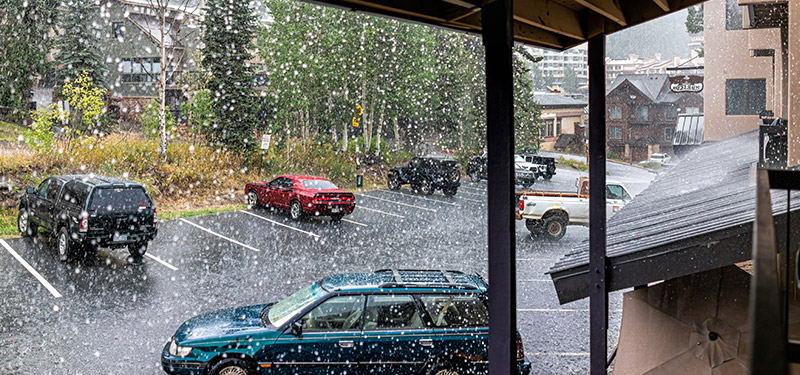The climate of New England can vary significantly across the 500-mile (800 km) span from Northern Maine to southern Connecticut. In recent years, the region has experienced a seemingly unprecedented increase in precipitation – rainfall in particular. While many suggest climate change is to blame, there is no question that low pressure systems, associated with inclement weather, have resulted in frequent wet and gloomy days. Heavy rains often accompany strong winds, and wind and water together can be a destructive force, resulting in water infiltration.
While proactive and reactive measures can prove to be expensive, it is less costly for a community to be proactive than it can be to deal with the damage water intrusion can do to buildings, to the personal property, health of residents, and to the finances of a condominium community.
Many of New England’s condominium buildings are sided with wood, vinyl, or cement composite clapboard siding, or panel cladding material. For the most part, when installed properly as part of a building envelope system, these materials do a good job of keeping moisture out of the building. However, what is seen on the exterior is not the only barrier. Another component of exterior walls is the building wrap placed over the building sheathing, but behind the visible siding material, often including a wind barrier, or as warranted a water retention barrier. There are also various types of flashing, which are thin pieces of impervious material installed to prevent the passage of water into a structure from a joint or as part of a weather resistant barrier system. The term weathertight, in construction parlance, indicates the point in the building process to describe when a structure is sheltered from the weather, where it must be wind and watertight. The components necessary to achieve this are part of the building envelope system, that includes all components that separate the indoors from the outdoors of a building. The building envelope includes the entire outer shell, including exterior walls, foundations, roof, siding, windows, glazings, and doors. A successful building envelope design should prevent air leaks and moisture intrusion through an exterior wall by applying continuous air and moisture barriers to manage water infiltration and accumulation. Any defect in a building envelope system, even as simple as overlapping a water protective membrane the wrong way, can have significant consequences leading to building damage.
When property managers and board members worry about weather-related water damage, they are likely considering damage caused by flooding at the bottom of a building, or by a leaky roof at the top. Balconies and surface transitions can be particularly problematic. However, another peril that condominiums face is the peril of wind-driven rain. Rain, by itself, falls vertically and can result in damage to structures, but when wind is added to the mix, the horizontal force propels water at the building exterior, and the risk of interior damage can magnify. When wind-driven rain intrudes into a building, it can result in leaks, water damage, and, ultimately, rot and mold growth can follow. Structural framing and sheathing can deteriorate and lose its integrity. As to interior units, water intrusion may result in costly repairs to the flooring, walls, fixtures, finishes, furnishings and other contents of a dwelling space, coupled with the loss of its use during a period of repair.
The term “curb appeal” exists for condominiums and condominium complexes. It provides a first impression, an attention-grabbing detail or feature that makes a community appear like somewhere to call home. This extends beyond creating inviting landscapes to reflect the New England changing seasons, but also extends to creative and often innovative design. There is a push to stand out, and architects and developers seek out varying materials to make a building more alluring, create appeal with different shapes and angles to create architectural interest, or in some cases select systems that require very specific installation methods and engineered building envelope designs to properly install. While innovation can add architectural interest to a building, each angle or transition, or penetration through the building envelope, and each transition or termination point, creates another potential location for water intrusion. As many of our clients have unfortunately realized, “cool designs” can result in large water intrusion issues.
Another factor that cannot be overlooked is workmanship. Even with the best materials and specifications, if those materials are installed incorrectly, the materials may not perform as intended. For this reason, the retention of properly qualified tradesmen is important, but proper supervision and oversight is required to ensure the work has been done adequately, so as to maintain a building envelope free of sources of potential infiltration. Cutting corners at the time of construction can lead to significant and widespread issues that need to be addressed. Construction defects are a hallmark of any building boom, and what has been seen in New England recently is no exception. While there may not be publicly available numbers as to the frequency of such complaints, we see patterns in our practice that involve latent defects that typically spring up within the first several years after construction is completed.
Regardless of who is initially responsible, water intrusion is one of the most common sources of reactive headaches and hassles for building owners, managers, and residents. Despite major advances in building materials and construction methods, these issues persist, and building envelope systems are tested by New England’s wind driven rains. There are potential risks that the boards and managers of communities can reduce by being proactive.
1. Some insurance policies exclude wind-driven rain as it is not a specifically listed peril. Other policy forms limit coverage for wind-driven rain claims if there is no associated physical damage to the building envelope. Some insurers offer specific wind-driven rain endorsements. Notably, wind-driven rain is not covered within flood coverage. It is wise for a community’s representatives to consult an insurance broker regarding available coverage.
2. As part of a preventative maintenance plan, consider a property condition assessment to survey and evaluate the condition of the building envelope.
3. The property manager should conduct periodic inspections several times each year designed to track warning signs such as ponding on roofs, efflorescence, cracks in brickwork or coatings, openings in joints, staining, surface deterioration, and other signs of water infiltration.
4. The property manager or board should also periodically survey condominium residents about any moisture in individual units. To the extent there is moisture, an assessment may be necessary to ascertain whether it is being generated from the common areas.
5. Where water intrusion is identified, do not ignore or underestimate the potential problem, or employ short-sighted shortcut repairs.
6. Water infiltration investigations must occur through a case-by-case, location-by-location process, with no exact formula. Issues with wind-driven rain can be particularly hard to pinpoint as the leaks are often identified at locations closer to ground level than the infiltration point.
7. Conclusively determine the origin and cause. A leak can start from an opening as small as a pinhole, and left unrepaired, can develop over time into a significant and costly problem, even passing through penetrate through layers of wood, concrete, brick, steel, or insulation. Never assume the water intrusion is isolated to one location when similar locations may have been constructed similarly, with the same design or workmanship errors.
8. Where multiple leaks are identified, retain a building envelope consultant to determine if leaks are localized, or systemic. It is often far more cost-effective to bring in an expert at the outset and determine what is really going on, how widespread the issue is, and how to properly address it.
A community’s repair budget, and an evaluation of the severity of the leak, as well as its location may help determine the plan of action. In cases where a community is working with limited funds and the leak can be pinpointed with relative certainty, it may make sense to go ahead and effectuate repair rather than incur expert costs; however, if the problem is systemic, a community should be prepared to deal with it through a systemic approach. Often, there is no quick or inexpensive fix for water intrusion. In the event that a systemic issue is identified, condominium communities should consider repair and replacement options. By example, when flashings or wind and water barriers were not installed correctly, they need to be reinstalled properly to correct the defective condition. However, if doors and windows were not installed properly, a replacement may not be necessary; sometimes, depending on the condition of materials, a proper re-installation may be sufficient.
Water damage claims involving condominium complexes are on the rise. While proactive and reactive measures can prove to be expensive, it is less costly for a community to be proactive than it can be to deal with the damage water intrusion can do to buildings, to the personal property, health of residents, and to the finances of a condominium community. In the event that your community encounters issues with water infiltration, Moriarty Bielan & Malloy LLC is available to provide recommendations for investigating the source and scope of the issue, evaluating damages, and pursuing claims against potentially responsible parties.


